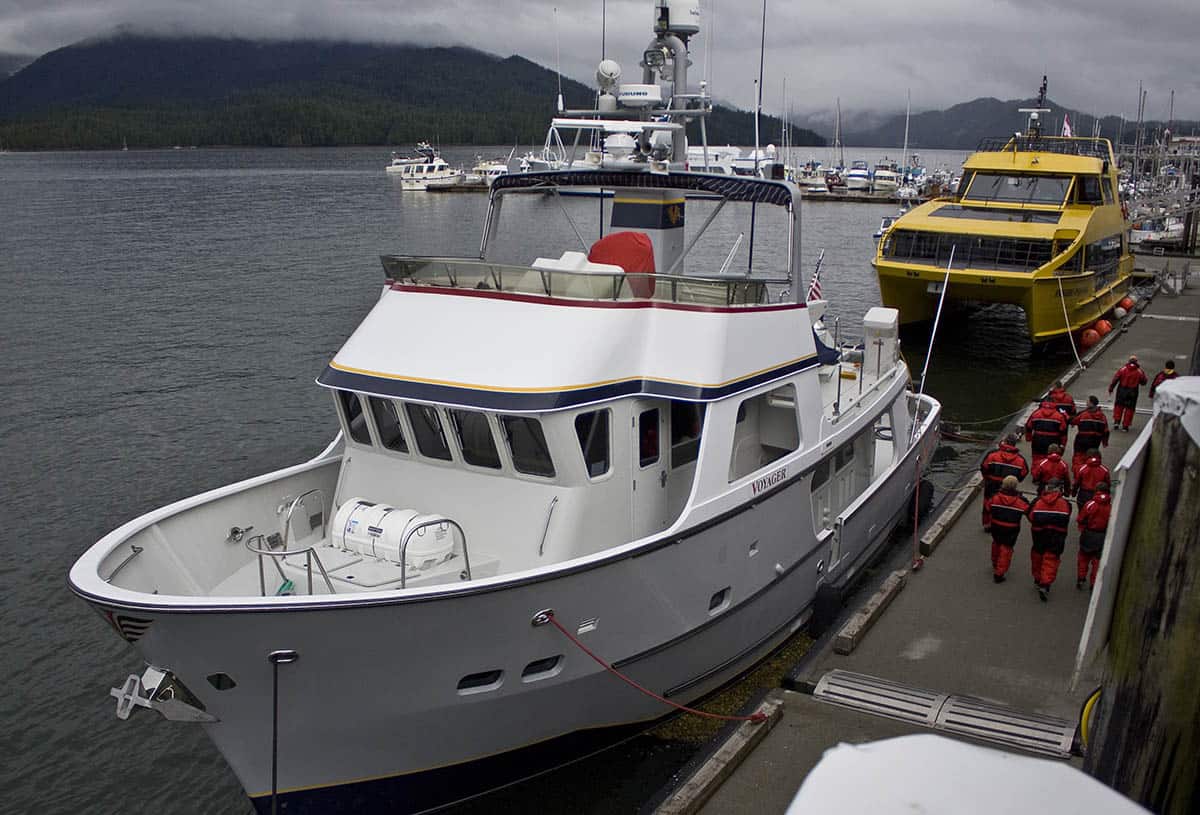
Picture by: Wikipedia
I’d never before pondered that fish and noise might—even indirectly—have anything to do with each other. Little did I know! Sure, fish do tend to be quiet, but the process of harvesting them most assuredly does not.
With high casualty, accident, and injury rates, fish harvesting ranks as one of the world’s most dangerous industries. Occupational Health and Safety (OH&S) and Workers’ Compensation Board (WCB) literature from coastal communities not only confirms this; it also highlights noise-induced hearing loss (NIHL) as a primary health hazard among fish harvesters. What these regulatory bodies haven’t addressed is the noise-induced fatigue caused by insufficiently sound-attenuated crew quarters. Cumulative health effects of noise exposure over time also include cardiovascular stress, which can lead to high blood pressure and dizziness.
While working on a staff profile recently, I learned about BAP Acoustics consultant Giorgio Burella‘s groundbreaking PhD work at the Memorial University of Newfoundland, widely recognized for their Department of Ocean and Naval Architectural Engineering. Giorgio Burella and Lorenzo Moro, “Design solutions to mitigate high noise levels on small fishing vessels”, Applied Acoustics, Volume 172, 2021, DOI—the culmination of Giorgio’s (and others’) research—holds the promise implied in its title.
Many international studies have shown that hazardously loud (> 85 dBA) noises—usually emitting from propulsive engines and auxiliary machinery—can cause hearing loss by virtue of their excessive volume and length of exposure time. One of several factors revealing the Memorial University studies as unique is that the team’s research was the first to address noise-induced fatigue and the conditions that would put those working aboard a small-scale fishing vessel at risk. In terms of habitability, sleeping quarters can pose a particularly insidious risk.
According to WorkSafe BC, most hearing-related OH&S information Is based on 8-hour workdays. Unsurprisingly, fish harvesters’ “work days” tend to exceed 8 hours. The provincial agency further maintains that sleeping quarters unattenuated to noise below 55 dBA don’t provide an occupant’s ears with enough rest time during sleep to recover from earlier, louder exposure.
Wearing earplugs while sleeping can reduce noise levels to below 40 dBA.
Meanwhile, out on deck…
Aside from engine and machinery transmissions, noise from handling lobster pots and other fish harvesting gear can definitely be loud enough to cause hearing damage with frequent exposure.
An industry-led organization committed to helping reduce injuries and save lives at sea, the Newfoundland and Labrador-Fish Harvesting Safety Association (NL-FHSA) recommends that fish harvesters protect themselves by:
- understanding where noise is coming from and determining whether volume exceeds safe levels
- controlling noise at the source: selecting equipment with low noise levels; isolating engine rooms and other noisy areas with sound insulation or enclosures*
- modifying the amount of time spent around noise sources
- wearing personal protective equipment (PPE) to protect hearing, even for short-duration tasks
- having hearing tested if concerned.
*Noise mitigation at the source is a key acoustical engineering principle
and steadfastly recommended course of action… on land and at sea.
WorkSafeBC, WCB, and related organizations advise the use of hearing protection devices (HPDs), which can and do play a significant and effective role in limiting hazardous noise exposure, but… these things only tend to work when people wear them. The research team found that sea harvesters often declined to wear HPDs for numerous reasons, including the ways in which HPDs can impede important—itself often safety-related—communication between crew members. This exemplifies a situation in which HPDs are both needed and contraindicated.
*Noise mitigation at the source is a key acoustical engineering principle
and steadfastly recommended course of action… on land and at sea.

HPDs: quite effective. If you wear them.
Conclusions & Recommendations
Predominantly a small-scale industry, fish harvesting in Newfoundland and Labrador provides many coastal communities with a means of livelihood and a sense of identity.
The Memorial University research has proven novel in ways far too numerous and complex for the scope of a humble blog post. In addition to conducting a comprehensive survey across their 12-vessel sample, Giorgio and his team developed a unique methodology combining two well-known numerical approaches—Statistical Energy Analysis (SEA) and graph theory—to yield highly accurate noise assessment and, drawing on their findings, solid recommendations around its mitigation.
Finding that airborne noise sources most affect crew space habitability, and having calculated secondary structure-borne noise paths on upper decks, the research team concludes that:
- decoupling the main engines via resilient mounts is not effective in reducing noise on the vessel;
- sound absorbing material (e.g. mineral wool) should be applied on all engine room walls and the ceiling;
- the doorway to the engine room should be selected to have an adequate sound insulation performance, and any gap should be filled;
- a floating floor should be installed in the space immediately above the engine room;
- to further decrease the noise levels, , viscoelastic materials (VEM) in constrained layer damping (CLD) configuration should be applied on the surfaces that separate the engine room from the crew quarters.
Moreover, research results show that:
- SEA is a powerful tool to predict noise on small vessels;
- the Marty-Pascoa-Santo (MPS) algorithm within an SEA noise transmission model can be used to identify critical spots on the vessel and tailor the solutions, and;
- noise mitigation can be achieved with simple and economic interventions.
Ahoy: Going forward
Potential abounds for applying the work of Giorgio and his colleagues. Plans are in place to share research results with fishing vessel designers, owner-operators, and crews. Eager to discuss proposed solutions and understand any implementation challenges they’ve yet to identify, the researchers will communicate with these key stakeholders drawing on the same community-based approach that informed their work with fish harvesters.
While the research team chose not to analyze outdoor deck noise levels—an undertaking well beyond the scope of one project—during the above-cited research work, they will undertake further studies designed to identify solutions for mitigating noise-induced hearing loss risks associated with fishing gear use.
On an informal note, I’d like to thank Dr. Giorgio Burella for his generosity in sharing the wealth of information upon which my little former-English-major-tries-to-understand-big-science article is based, as well as to congratulate him (and his co-skipper) on the new addition to their crew! May your sailings be smooth and your sleeping quarters within habitable decibel range.
Acknowledgements
Findings referred to in this post originate from a research project undertaken at the Memorial University of Newfoundland. Led by Principal Investigator Dr. Lorenzo Moro and titled “Long- and short-term solutions for mitigating hazardous noise exposure and noise levels on board vessels from the small-scale fishing fleet of Newfoundland and Labrador”, this seminal project received generous funding from: the SafetyNet Centre for Occupational Health and Safety Research of the Memorial University of Newfoundland; the Newfoundland and Labrador-Fish Harvesting Safety Association (NL-FHSA); Mitacs Accelerate; and the Natural Sciences and Engineering Research Council of Canada (NSERC)
Interested in joining the BAP Acoustics team? Visit our Careers page.



